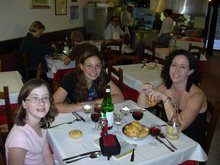
BIBLIOGRAPHY
Janeczko, Paul B. THAT SWEET DIAMOND: BASEBALL POEMS. Ill. by Carole Katchen. 1998. Atheneum Books for Young Readers.
You can almost hear the crack of the bat and smell the peanuts and hot dogs when you taste the nineteen baseball poems. Janeczko makes full use of imagery and onomonopeia in many of his poems including:
BEFORE THE GAME
Pennants wave
on the souvenir stand
Sausages snap,
sizzle with onions on the grill
Girls with mitts
practice catches to be made
Scorecard
Ohhh-ficial scorecard
Boys, wearing caps of faraway teams,
laugh, shove
Peanut shells crunch
underfoot
Cheese oozes
over nachos
Joy
thick as the perfume
of popcorn and
boiled hot dogs
fills the air
as
ticket takers call,
This way
This way to the game
Each double spread contains the poem on one side and the illustration on the other side. The poems are about all of the sights and sounds experienced in baseball including the pitcher spitting, and the vendors hawking their peanuts and iiiiiice cream. The poems vary in length from ones that take up the entire page, to a four line poem about a pitcher:
A Curse upon the Pitcher
Peanut shells, pigeon feather,
Dance a jig in stormy weather.
Ice cream stick, bubble gum,
Hurler, may you lose your hum.
Carole Katchen's illustrations complement the poems perfectly. The illustrator's use of pastels show the feelings and emotions experienced in America's pastime. The paintings use of definition is minimal; the spectators and players blend into the background. The colors used are bright and realistic, varying with the subject of each poem.
This anthology of baseball poems is an excellent choice for all baseball lovers or anyone who has ever experienced the sights and sounds of a baseball game.



